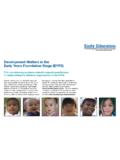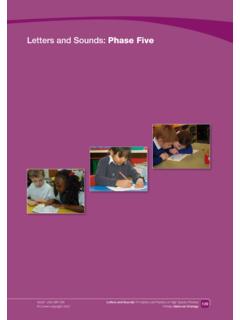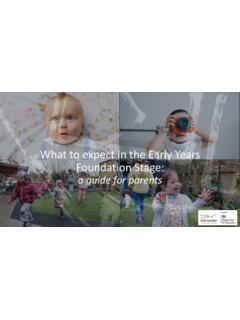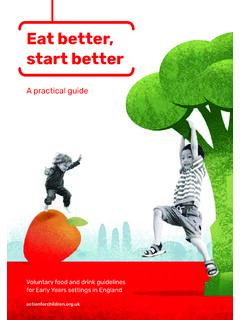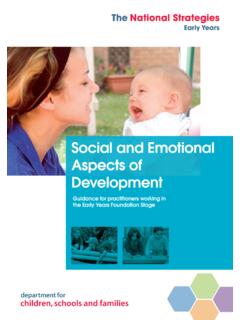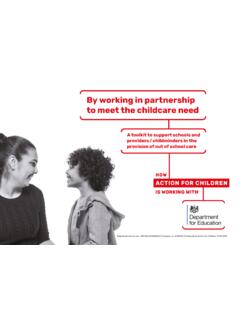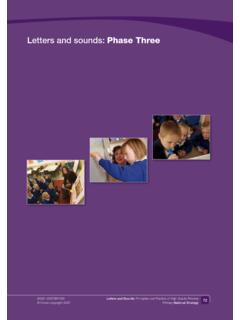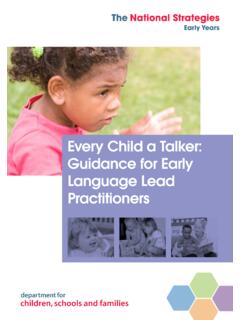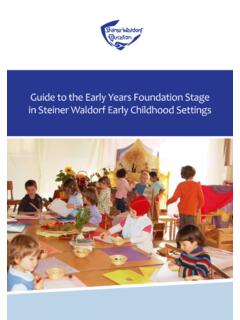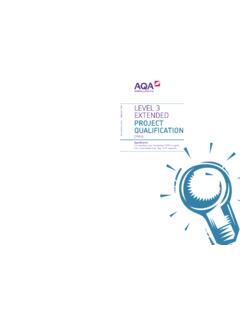Transcription of Principles for early years education
1 Principles for early years educationThese Principles are drawn from, and are evident in, good and effectivepractice in early years education requires both a relevant curriculum and practitioners whounderstand and are able to implement the curriculum education requires practitioners who understand that childrendevelop rapidly during the early years physically, intellectually, emotionallyand are entitled to provision that supports and extendsknowledge, skills, understanding and confidence, and helps them toovercome any should ensure that all children feel included, secure and must build positive relationships with parents in order to workeffectively with them and their years experience should build on what children already know and should also encourage a positive attitude and disposition to learn andaim to prevent early child should be excluded or disadvantagedbecause of ethnicity, cultureor religion, home language, family background, special educational needs,disability, gender or and practitioners should work togetherin an atmosphere of mutualrespect within which children can have security and be effective, an early years curriculum should be carefully structure, there should be three strands: provision for the different starting points from which children developtheir learning, building on what they can already do.
2 Relevant and appropriate content that matches the different levels ofyoung children s needs; planned and purposeful activity that provides opportunities for teachingand learning, both indoors and should be opportunities for children to engage in activities planned byadults and also those that they plan or initiate do notmake a distinction between play and work and neither shouldpractitioners. Children need time to become engrossed, work in depth andcomplete must be able to observe and respond appropriately to children,informed by a knowledge of how children develop and learn and a clearunderstanding of possible next steps in their development and , purposeful activity and appropriate intervention bypractitioners will engage children in the learning processand help them makeprogress in their for early years education11 For children to have rich and stimulating experiences, the learningenvironment should be well planned and well provides thestructure for teaching within which children explore, experiment, plan andmake decisions for themselves, thus enabling them to learn, develop andmake good all.
3 Effective learning and development for young children requireshigh-quality care and education by Principles are the basis on which every part of this guidance has beendeveloped, and are reflected the Principles into practiceThe following section sets out the common features of good practice thatwill result from these Principles . It also gives examples that show how theyhave been put into practice in a range of different should ensure that all children feel included, secure and practitioners should work together in an atmosphere ofmutual respect within which children can have security and confidence. For example, at a nursery, the children start to visit with their parents asbabies or toddlers. By offering childcare and group work with and apartfrom children, practitioners help parents develop skills that support themand their children.
4 They encourage parents to share their knowledge andviews of their child s development and raise any concerns. The setting hasa multilingual practitioner who relates with families from a range of ethnicand cultural traditions. She ensures that families know about the servicesavailable and is a link between the families, key staff and other practitioners ensure that the displays and resources reflect children shome and community experience. Before admission at age three, apractitioner visits the family and child at home to get to know them. Thefamily is given information in an accessible format about the way sessionsare organised that outlines how different activities contribute to thecurriculum. The parent is encouraged to stay with the child as part of theprocess of transition between home and the group wherever possible andarrangements are flexible to accommodate the needs of working the family s association with the setting, the key practitioner,parent and child talk regularly to check how well they are all adjusting tothe arrangements for settling in, learning and teaching.
5 She makes surethat the family or child s particular interests and experiences, such as thebirth of a new baby, are used in planning work with the child. When thechild transfers to primary school, the practitioner ensures that the parentknows how to select a school and how the transition will work. She meetsthe parent to prepare the final record of the child s progress andattainment. She liaises with the receiving school and the family so thateveryone is kept fully the Principles into practiceThese principlesrequirepractitioners to work inpartnership with parents tosupport each individual childand ensure no child isdisadvantaged or is demonstrated whenpractitioners: manage carefully thetransition between homeand setting and betweendifferent settings, tosupport everyone involved; establish feelings of trustand respect with parentsand children; treat children as individualsto ensure each has equalityof opportunity; find out about the child sethnic, faith and culturalheritage and homeexperiences, so thatfamiliar experiences andinterests can be used asstarting points for learningand teaching.
6 Promote self-confidenceand a positive attitude tolearning in all children,whatever their gender,ethnicity, home language,special educational needs,disability or ability; recognise that beingsuccessful and feelingconfident and secure aremajor factors in protectingchildren against education requires both a relevant curriculum and practitionerswho understand and are able to implement the curriculum education requires practitioners who understand that childrendevelop rapidly during the early years physically, intellectually,emotionally and example, as part of the training plan negotiated with and supportedby the managers of their settings, a group of practitioners and parentsfrom several types of setting meet regularly to share experiences and group work is a valuable part of systematic training and alerts peopleto other training opportunities.
7 Most have been on training coursesprovided by a range of early years support groups and charities and toworkshops run by individual settings. Some have gained qualifications,such as an NVQ level 3 or a degree in child development and/or meetings have focused on supporting early literacy and talkingwith children. The current meeting is to help practitioners and parentshelp children to resolve conflict. In small groups, adults with differenttypes of training and experience list typical situations in which conflictsoccur. When the lists are compared, similar situations are identified; theseinclude taking a toy from another child, having a tantrum when asked tochange an activity, sitting next to a child who does not want this, anddisrupting other children s groups discuss how to step in and what to say to help the childreninvolved develop the skills they need to resolve their conflicts.
8 The ideasare then shared to find the best method. The notes of the meeting helppeople reflect on what is reasonable at different stages of children sdevelopment and the different ways in which children the Principles into practices13 These principlesrequirepractitioners to understandhow children develop andlearn during the early is demonstrated whenpractitioners: have an understanding ofhow children develop andlearn from birth to age six; have a clear awareness ofthe knowledge, skills,understanding andattitudes to learning thatchildren need to acquire inorder to achieve the earlylearning goals by the endof the foundation stage; are aware of how childrenlearn most effectively sothat they can identify therange of needs andlearning styles within theirgroup; are aware of those childrenwho may requireadditional help and thosewho are more able and ofhow support needs to beprovided; evaluate their practice,recognising the importanceof identifying and meetingtheir training child should be excluded or disadvantaged because of ethnicity,culture or religion, home language, family background, specialeducational needs, disability, gender or children to have rich and stimulating experiences, the learningenvironment should be well planned and well the Principles into practiceThese principlesrequirepractitioners to plan alearning environment,indoors and outdoors, thatencourages a positiveattitude to learning throughrich and stimulatingexperiences and by ensuringeach child feels included.
9 Thisis demonstrated whenpractitioners: use materials, equipmentand displays that reflectthe community the childrencome from and the widerworld; plan an environment freefrom stereotypical imagesand discriminatory practice; include the localcommunity andenvironment as a source oflearning; encourage children tomake choices and developindependence by havingequipment and materialsreadily available and wellorganised; provide resources thatinspire children andencourage them to initiatetheir own learning; give the children the spacethey need for years experience should build on what children already know andcan , purposeful activity and appropriate intervention bypractitioners will engage children in the learning example, the practitioners in a pre-school have set up a hospital . Thisarises in response to a child s experience of breaking an arm and bringingin her X-ray, and the children s interest in her plaster cast.
10 Practitioners andchildren decide that the hospital needs a reception area with a telephone,appointment book, pencils and notepad. Children take the role ofreceptionist, answering calls and making appointments and relevant writing uses a number of well-known letters or approximations ofletters or numbers. Children dress as nurses and doctors, attend to patientsand write prescriptions, which the patients take away. A practitionershows children how to use bandages. He becomes a patient so that thechildren can practise on him. He draws a child who is being disruptive intothe play. The practitioner and children talk about taking temperatures andrefer to known and big numbers. They make the connection between a hightemperature and evidence that something is wrong. Although children joinand leave the play, many sustain their attention for a long time.
